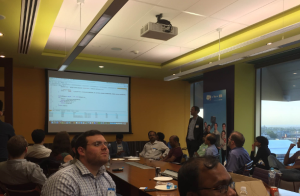
The Sydney Salesforce Developer Group kicked off 2016 with a look ahead towards exciting features in the Spring ’16 release of Salesforce, as well as a deep-dive into the potential of Lightning components. The group is a great way for developers to catch up on changes in the industry with like-minded individuals who face similar daily challenges. The group has grown in size from meetup to meetup, which is a testament to the information we share and the support we provide each other.
Thanks to James Coffey, APAC Regional Manager for Strategic Alliances at Salesforce, we were able to take a step through the looking glass and hold our most recent meetup at the Salesforce office itself. After getting to know some new faces and eating (too much) pizza (I lied, there’s no such thing as too much pizza), Chris Baldock, Senior Technical Consultant at Cloud Sherpas, presented us with a preview of the new features that will be available in Spring ’16. Spring continues expanding the scope of Lightning Experience, bringing us closer to a fully-realised modern user interface for the platform.
But there’s a lot more to it than that; the release notes weigh in at 448 pages! Thankfully, there’s people like Chris in the world willing to do the dirty work and read every page so that we don’t have to. He managed to fit a lot of content into a short timeframe, and was able to shine a light on new features that otherwise might have gone un-noticed. Asynchronous SOQL was a new addition to Winter ’16 that made it possible to use SOQL for data sets involving millions or even billions of records, but it flew under most peoples’ radars. Spring brings significant enhancements to its functionality, making many more SOQL commands compatible and turning the feature into a viable end-user option for many businesses.
DataColada’s own Engagement Manager Michael Sluis was up next, presenting us with the potential and possibilities to be had from using Salesforce Lightning Components. The components are a user interface framework that makes it easy to re-use code snippets across device types as well as across apps, making it possible to rapidly develop and deploy specialized applications for multiple business functions. In addition to outlining the technologies used by the components (Apex, CSS, Javascript, HTML/XML & JSON) and the high-level features they can provide, Michael provided a code example of how Lightning Components can be used to construct a Kanban scheduling chart.
The group meets every quarter at a different location, so if you’re thinking of joining I’d highly encourage you to do so. It’s a great place to listen as well as share your knowledge and experience with others, and no matter where you are on your Salesforce journey you’ll be sure to get great things out of it.





